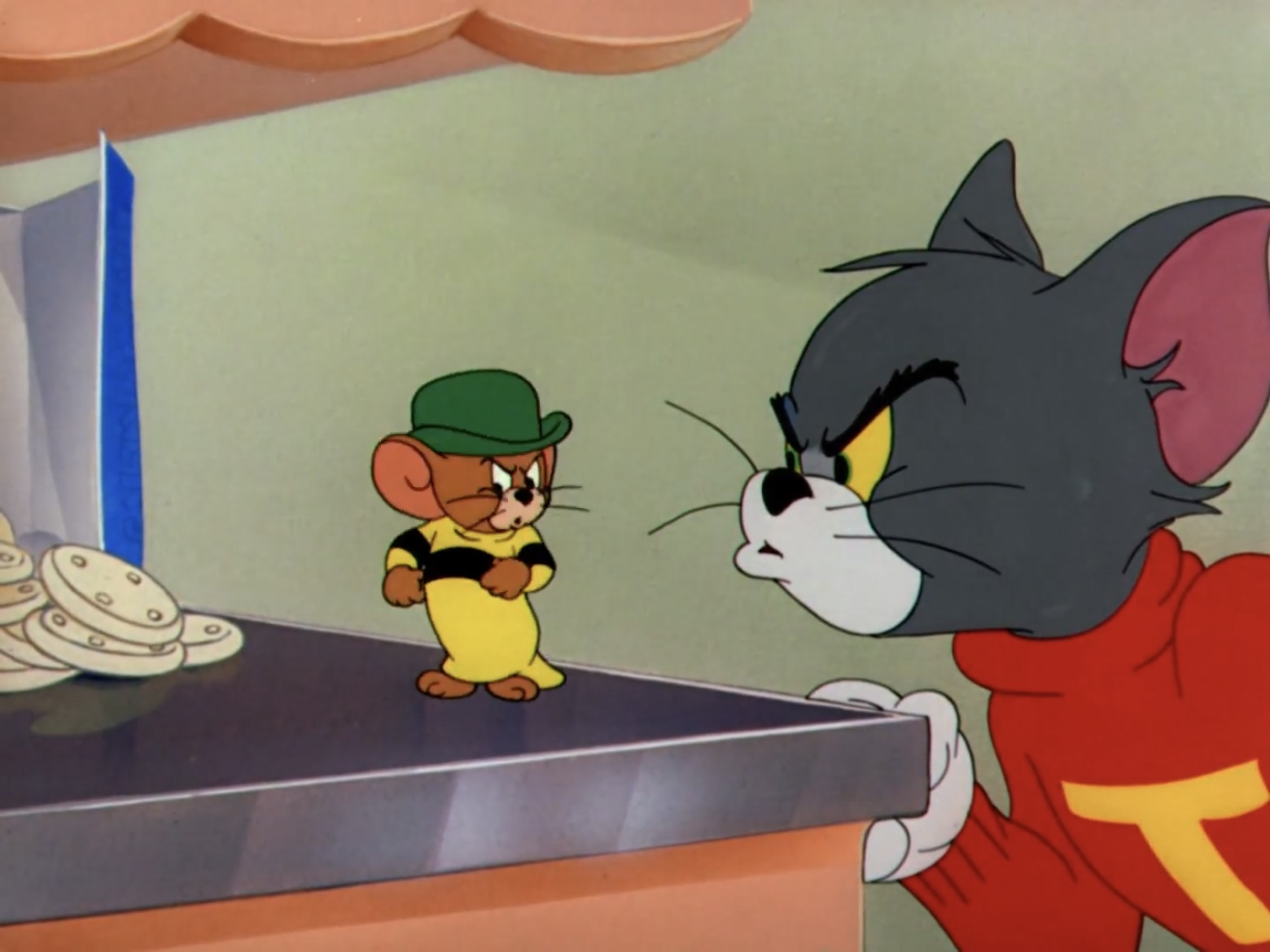Puss n' Toots marks the first of many cartoons in which Tom falls for a girl cat. In this film Mammy Two Shoes is asked to take care of a female cat, who Tom instantly gets a crush on. Tom tries to offer Jerry as a present to her, which doesn't work at all how Tom planned.
The pacing had been continuing to improve and by this film, it was near perfect. This pacing was mainly handled by William Hanna, and it is obvious that even this early in the series he had worked his craft to near perfection. The character's reaction here are funnier and more wild than they had been previously. They may not be at their height in this cartoon but by the next year those reactions would reach perfection. This is definitely a big step in the direction of the comedic brilliance of the cartoons to come.
Fitting the great pacing perfectly is Scott Bradley's music. Scott Bradley felt that working for cartoons was not only a privilege but an advantage he had over other composers. He had a particularly strong love for Tom and Jerry, because the cartoons' lack of dialogue. He felt this allowed him to experiment with music more than other directors would. This passion for what he did shows why his scores are so good. Unlike Carl Stalling (who composed music for Warner Brothers cartoons at this time), Bradley was not interested in using songs as puns to comment directly on the action. His scores instead were focused mostly on keeping the momentum of the cartoons going. Since the Tom and Jerry cartoons were speeding up so was the music. Bradley would state "... the average amount of music in a cartoon, due to it's fast tempo, is about 500 measures". This faster music fit this new faster pace perfectly.
However there aren't as many jokes as their would be in later Tom and Jerry cartoons, despite these other huge improvements. However this film is funnier than the previous cartoon Dog Trouble which had the same problem. A scene involving a record player is laugh out loud funny. The quality of the humor and the great pacing and character reactions make up for the fact that (strangely for such a fast paced cartoon) there just aren't many actual gags.
The animators on this film are George Gordon, Irven Spence, Jack Zander and Bill Littlejohn. All of them had worked on previous Tom and Jerry cartoons. However George Gordon, Bill Littlejohn and Jack Zander wouldn't stay with the series much longer. Bill Littlejohn would leave the series later the same year, while George Gordon and Jack Zander would leave the next year. Irven Spence would stay with Tom and Jerry until 1957. Again only William Hanna, Joseph Barbera and Fred Quimby would receive credit.
-Michael J. Ruhland
Resources Used
Of Mice and Magic: The History of the American Animated Cartoon by Leonard Maltin
http://www.imdb.com/title/tt0035226/
The Cartoon Music Book by Daniel Goldmark and Yuval Taylor
The pacing had been continuing to improve and by this film, it was near perfect. This pacing was mainly handled by William Hanna, and it is obvious that even this early in the series he had worked his craft to near perfection. The character's reaction here are funnier and more wild than they had been previously. They may not be at their height in this cartoon but by the next year those reactions would reach perfection. This is definitely a big step in the direction of the comedic brilliance of the cartoons to come.
Fitting the great pacing perfectly is Scott Bradley's music. Scott Bradley felt that working for cartoons was not only a privilege but an advantage he had over other composers. He had a particularly strong love for Tom and Jerry, because the cartoons' lack of dialogue. He felt this allowed him to experiment with music more than other directors would. This passion for what he did shows why his scores are so good. Unlike Carl Stalling (who composed music for Warner Brothers cartoons at this time), Bradley was not interested in using songs as puns to comment directly on the action. His scores instead were focused mostly on keeping the momentum of the cartoons going. Since the Tom and Jerry cartoons were speeding up so was the music. Bradley would state "... the average amount of music in a cartoon, due to it's fast tempo, is about 500 measures". This faster music fit this new faster pace perfectly.
However there aren't as many jokes as their would be in later Tom and Jerry cartoons, despite these other huge improvements. However this film is funnier than the previous cartoon Dog Trouble which had the same problem. A scene involving a record player is laugh out loud funny. The quality of the humor and the great pacing and character reactions make up for the fact that (strangely for such a fast paced cartoon) there just aren't many actual gags.
The animators on this film are George Gordon, Irven Spence, Jack Zander and Bill Littlejohn. All of them had worked on previous Tom and Jerry cartoons. However George Gordon, Bill Littlejohn and Jack Zander wouldn't stay with the series much longer. Bill Littlejohn would leave the series later the same year, while George Gordon and Jack Zander would leave the next year. Irven Spence would stay with Tom and Jerry until 1957. Again only William Hanna, Joseph Barbera and Fred Quimby would receive credit.
-Michael J. Ruhland
Resources Used
Of Mice and Magic: The History of the American Animated Cartoon by Leonard Maltin
http://www.imdb.com/title/tt0035226/
The Cartoon Music Book by Daniel Goldmark and Yuval Taylor





